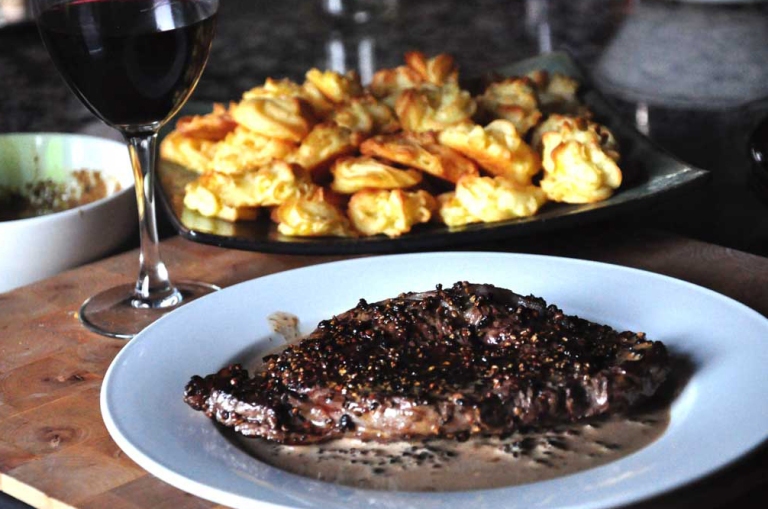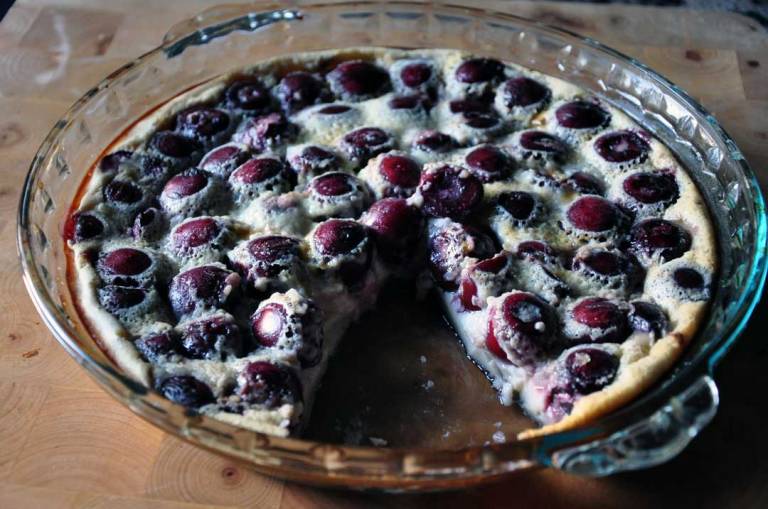- Lavender and tulsi citron pressé
- Gruyère and thyme gougères
- Shaved summer vegetable salad with honey dijon vinaigrette
- Steak au poivre with brandied peppercorn pan sauce
- Pommes Duchesse
- Cherry clafoutis
As if Peru wasn’t enough of a challenge, My little guy threw us another gastronomic curveball this week. Probably inspired by Bastille Day celebrations in mid-July (or the horrific coverage of Nice, which I’m unnerved that he knows of), he curtly announced we would be vicariously voyaging to France.
He’s no stranger to the bounty that is French cuisine. He’s swiped many a fork through an endless assortment of French sauces (though he, like ordinary American kids, most adores pasta in béchamel). He’s smitten with the idea that French kids start their day with a dark, creamy cup of hot chocolate and a croissant smeared with jam and butter, and then break for a heartier salad-and-meat lunch, complete with camembert and a baguette (which is actually a great packed lunch idea!). But he has, just the same, indulged in egg benedict and pain perdu (our plain and hardy French Toast is savory, East African–style), and flaky quiche, and often pleads on Sunday mornings for fruit-filled crêpes. He’s in love with French soups of any manner—exulted most by the idea of a simple bisque of mushroom or asparagus, or a hearty French onion soup. And, he’s helped me sift and strain and stir ingredients for a long list of French-inspired desserts: sweet custard for crème brûlée; crème pâtissière for mille-feuilles (he adores Napolean), éclairs, and fraisiers; ganache in all consistencies for mousse-filled tortes, tarts, and profiteroles, and every manner of gâteau, as well as for macarons.
His own research on the country yielded wonder on how diverse the country is, both of people and terrain, and how integral food is to all of it.
That’s why planning for this French-inspired meal was an elaborate affair.
I tried to set it up as a multi-course meal. You’d think I’d have been cooking all day, but, my husband and I split the menu and, stunningly, we got it all done in just under an hour.
In lieu of the customary aperitif, which I explained to my little guy, serves to “open the appetite,” I’d planned a lightly honied lemonade infused with dried lavender (calling to Provence in the summer). But, as it turned out, our local Kroger didn’t carry the versatile herb in any form outside of potpourri. So, improvising, I steeped a teabag stuffed with dried lavender and tulsi—which is “holy basil,” sharp and aromatic, carrying hints of peppermint and cloves—sweetened it, chilled it, and added a squeeze of lemon. The lavender and tulsi paired together are an absolute keeper, but the lemon added another dizzying dimension. Just to note, in France, if you ask for lemonade, you’ll likely be handed a Sprite. Their name for this kind of beverage is citron pressé. Regardless, this one stays in the arsenal forever.

I figured a lavender-scented lemonade would pair well with a light hors d’oeuvre laced with another bushy French relative: thyme. So I set out to make thyme gougères with grated gruyère. Alas, in my haste and inattention, I burned them to a dark crisp—and with that calamity smoldered our expectations for our elaborate French dinner.
Fortunately, just at that moment, Seemay walked in with an excellent bottle of French bandol rosé—from Domaine de la Garenne, a vineyard that straddles pine forests near La Cadière d’Azur, in Provence—and our spirits were again on course. Thank goodness for good friends.
We snacked on our burned gougères even as we felt robbed, but we happily made short of our next course—the entrée: Summer squash, fennel (I used both root and tips) and radishes shaved paper thin, and blanched asparagus, dressed in a quintessentially French shallot and dijon mustard vinaigrette.

And now for some contexte. One thing I’ve learned on this vicarious excursion that’s important is that the “entrée” in French cuisine differs markedly from its North American usage, which describes a starring meat course. In France, it’s the dish served before the main course—le plat principal—and after a lighter course, in our case, the (sadly charred) hors d’oeuvre, which the Brits call a “starter” and the Americans, an “appetizer.”
So, onwards to le plat: steak au poivre with pommes duchesse (and as you see, having friends at the table allowed us to open another beautiful bottle of wine, this time, a ruby-tinged cabernet sauvignon).

Cooking steak to perfection is a serious thing here in Texas—and it is rarely eaten doused in sauce (unless it’s chicken-fried steak, and I’m sorry, that will never be a keeper recipe). But I’d argue that steak au poivre is a reasonable improvement to naked beef.
The simple addition of a peppercorn crust protects the meat from overcooking as it is seared on a blistering hot cast-iron skillet; and the remnants of the crudely crushed toasted peppercorn become elemental in the pan sauce of reduced cognac (we used brandy), heavy cream, and pan fond (which is the French words for those roasted bits of meat). Notably, and Texan cooks—even the best of you—pay attention: Salt (plain ol’ kosher, in our case) is sprinkled onto the cut after it is seared to preference, just before it is dressed with the peppercorn pan sauce—never before, as The Everyday French Chef notes, because it draws out the juice from the meat.
Pommes duchesse is another French cuisine classic. It appeared in a 1817 cookbook so appropriately titled: “La Nouvelle Cuisinière Bourgeoise.” But though it looks extraordinary, it is so simple. It entails pureeing boiled potatoes with egg yolk, and butter (use the Vitamix for this for the most delicate, lump-free puree). That concoction is then seasoned and piped into pretty rosettes onto a parchment-lined baking sheet, and baked until golden. The result is a fluffy swirl of protein-packed potato, delectably crunchy at first bite, and creamy on the inside.

I contemplated skipping dessert owing to time constraints on this one, but it wouldn’t be doing justice to France’s ornate gastronomic heritage. So, in lieu of a complicated, sophisticated entremet, I chose to try my hand at a cherry bejeweled, rustic clafoutis.

The idea of a clafoutis is utterly beguiling: get some ripe summer fruit, cover it with custard, and bake for a flan studded with sweet, molten fruit. But as this excellent piece from The Guardian warned, clafoutis can easily go wrong. It can be too sweet, too stiff, too bland, and the worst in my book, too eggy. There’s merit to macerating the fresh summer-picked cherries with a bit of caster sugar and brandy. Ships pitted them for me, but we left them in whole, and the fruit bled minimally. Although purists discourage it, I’m a bigger fan of vanilla bean than I’ll ever be of almond essence. However, I would counsel anyone attempting this perfectly sized recipe never, ever to skip the lemon zest.
Warm or chilled, every bite of this vision has a brandy-scented cherry that is covered in vanilla custard, which melts over the tongue before the fruit can be chewed. It’s a textural marvel that tied together an incredible experience.
We are lifetime fans of everything we made on this journey—even the sad gougères. A lesson without pain is meaningless, as many a wise person has noted. #ThisisaKeeper in the best respect.


Dear goodness, my mouth was watering reading through this. This is the kind of stuff I DREAM of. I think the pommel duchesse was my favorite, and something I absolutely MUST try. Keep cooking! This all divine!
LikeLiked by 1 person
Thank you so much for this incredibly sweet and encouraging comment. My apologies that it is so late—I need to find the time to keep writing. Thank you!
LikeLike